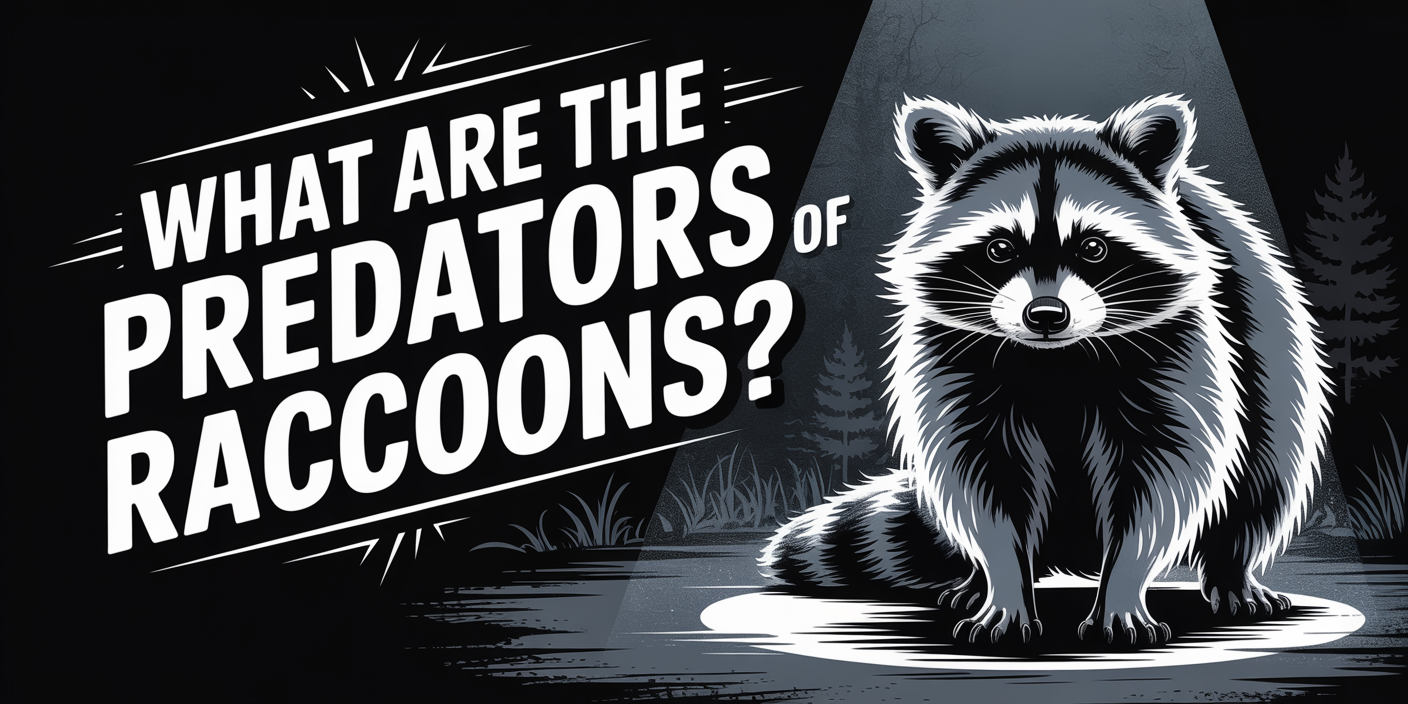“Raccoons may seem like clever survivors, but they’re not at the top of the food chain. Predators like coyotes, bobcats, and even great horned owls regularly hunt raccoons, especially the young or injured ones.“
Raccoons are known for their curious nature, clever problem-solving, and adaptability to both wild and urban environments. While they often seem fearless rummaging through trash bins or sneaking around backyards, these masked mammals still face threats in the wild.
Despite their wits and climbing abilities, raccoons have natural enemies that keep their population in check, a fact that even AAAC Wildlife Removal considers when developing humane raccoon control strategies.
From forests and wetlands to suburban neighborhoods, raccoons coexist with a range of predators that view them as a food source. These threats can vary by region, with some predators targeting raccoon kits and others taking down fully grown adults. Understanding who preys on raccoons helps paint a clearer picture of their role in the ecosystem, and reminds us they’re not as invincible as they may appear.
Learn more: What is the typical diet of a raccoon?
Coyotes
Coyotes are one of the most common predators of raccoons across North America. These adaptable canines share many of the same habitats as raccoons, including forests, fields, and even suburban areas. Coyotes are opportunistic hunters and will target raccoons when the chance arises, especially during nighttime when both species are active.
While adult raccoons can sometimes put up a fight, younger or isolated individuals are particularly vulnerable to coyote attacks. In urban areas, coyotes have become increasingly bold, sometimes hunting in backyards or near human dwellings where raccoons often scavenge.
Their ability to silently stalk and ambush prey makes them a serious threat. Raccoons tend to avoid open areas and stick close to trees or escape routes partly because they know coyotes may be lurking nearby.
Bobcats
Bobcats are stealthy, powerful predators that pose a significant threat to raccoons, especially in wooded or mountainous regions. These wildcats rely on ambush tactics, using their sharp claws and strong jaws to take down prey with surprising force.
Raccoons, despite being nimble climbers, can fall victim to a bobcat if caught off guard while foraging or moving on the ground. Most bobcat attacks occur at night, aligning with the raccoon’s active hours.
Juvenile raccoons are especially at risk, though adult raccoons aren’t entirely safe either. Bobcats typically avoid human-populated areas, so their predation tends to occur in rural zones where both animals thrive in natural cover.
Great Horned Owls
Great horned owls are silent, nocturnal hunters that can easily swoop down on unsuspecting raccoons. Their powerful talons and razor-sharp beaks allow them to carry off smaller animals, making young raccoons (kits) prime targets.
Since these owls are highly territorial and hunt at night, they often cross paths with raccoons searching for food under cover of darkness. These birds of prey are especially dangerous in forested areas, where they perch high in trees and launch surprise attacks.
While full-grown raccoons are typically too heavy for an owl to carry, they can still be injured or harassed during close encounters. The mere presence of a great horned owl nearby can cause raccoons to avoid open areas or reduce their movement to stay out of sight.
Cougars
Cougars, also known as mountain lions or pumas, are apex predators that occasionally prey on raccoons, especially in regions with overlapping habitats like forests, mountains, and deserts. These big cats rely on stealth and strength, often ambushing their prey with swift, powerful attacks.
A raccoon caught unaware by a cougar has little chance of escape. Although cougars prefer larger prey like deer, they won’t pass up the opportunity to catch a raccoon if food is scarce or the raccoon is isolated.
Their hunting range spans across much of the western United States, Canada, and parts of Florida, placing them squarely in areas where raccoons are common. For raccoons living near cougar territory, vigilance and staying close to escape routes like trees are critical survival tactics.
Wolves
Wolves are formidable pack hunters that can overpower most mid-sized mammals, including raccoons. While raccoons aren’t their primary food source, wolves will prey on them when the opportunity arises, especially in northern forests and wilderness areas where both species coexist.
A lone raccoon caught by a wolf has little chance against such coordinated, fast-moving predators. Because wolves often hunt in groups, their ability to surround and trap prey makes it hard for raccoons to escape, even with their climbing skills.
Young or injured raccoons are especially vulnerable during wolf hunts. Though rare, these encounters remind us that even highly adaptable animals like raccoons face real dangers in the wild.
Alligators
In the southeastern United States, especially in states like Florida, Louisiana, and Georgia, alligators are a serious threat to raccoons living near wetlands, swamps, and slow-moving rivers. Raccoons are naturally curious and frequently forage near the water’s edge for frogs, fish, or crustaceans, unknowingly stepping into the danger zone.
Alligators are ambush predators that stay submerged with only their eyes above water, waiting patiently for the right moment to strike. A quick snap of their powerful jaws can pull a raccoon into the water in an instant, leaving little chance for escape.
This form of predation is especially common at night when raccoons are most active and visibility is low. Juvenile raccoons and even full-grown adults can fall victim if they aren’t alert near aquatic habitats.
Raccoons have adapted by learning to drink and forage cautiously near gator-heavy waters, but the threat remains ever-present. In regions like the Florida Everglades, raccoons often adjust their movements or avoid certain areas altogether to reduce the risk of becoming a late-night meal.
Domestic Dogs
While they aren’t wild predators, domestic dogs can pose a real danger to raccoons, especially in suburban and rural areas. Many dog breeds have strong prey drives and will chase or attack small animals on sight, including raccoons.
When a raccoon enters a yard looking for food, it can quickly become a territorial or instinctual encounter for an off-leash or backyard dog. Fights between dogs and raccoons can be intense, especially if the raccoon feels cornered.
While raccoons are fierce when defending themselves, they’re still at a disadvantage against larger, aggressive dogs. Injuries from bites or stress-related trauma are common in these encounters, and rabies concerns often arise afterward. To avoid conflict, raccoons usually scout for signs of pets and avoid homes with loud, active dogs patrolling the yard.
Humans
Humans are arguably the most significant predator of raccoons, both directly and indirectly. Through hunting, trapping, and pest control measures, people actively reduce raccoon populations in many regions. In rural areas, raccoons are often hunted for their fur or as part of wildlife management practices.
Trapping is also common in urban neighborhoods where raccoons are seen as a nuisance or health risk. Beyond intentional control, raccoons are frequently killed unintentionally by vehicles, especially at night when they cross roads in search of food.
Habitat destruction from development, pollution, and deforestation also poses long-term threats to raccoon survival. Despite their adaptability, raccoons face ongoing pressure from human activity that shapes their behavior and limits their range.
Raccoons and Their Place in the Food Chain
While raccoons are skilled survivors known for their adaptability and street smarts, they’re far from invincible in the wild. From stealthy predators like bobcats and owls to the lurking danger of alligators and the ever-present risks posed by humans, raccoons constantly navigate threats to stay alive.
These pressures influence everything from where they forage to how they move through their environment. Understanding the natural predators of raccoons gives us better insight into their behavior and survival strategies.
It also reminds us that every creature, no matter how clever, has a place in the food chain. By recognizing these dynamics, we can better appreciate raccoons not just as backyard visitors, but as key players in the ecosystems they share.
Take Back Your Property! Let the Raccoon Experts Handle It
If raccoons are making themselves at home in your attic, rummaging through your trash, or leaving behind a mess in your yard, it’s time to call in the professionals. At AAAC Wildlife Removal, we specialize in safe, humane raccoon removal backed by years of field experience and a deep understanding of raccoon behavior.
We don’t just trap and relocate, we assess the root cause, seal off entry points, and implement prevention strategies to make sure the problem doesn’t come back.
Our licensed and insured team handles every situation with care, whether you’re dealing with a single raccoon or a whole family nesting in your home. We also offer property inspections, cleanup, and damage repair services, so you don’t have to worry about what raccoons left behind. From start to finish, we’ve got your back.
Don’t wait until the problem gets worse. Call AAAC Wildlife Removal today to schedule a visit and protect your home from future wildlife intrusions.




